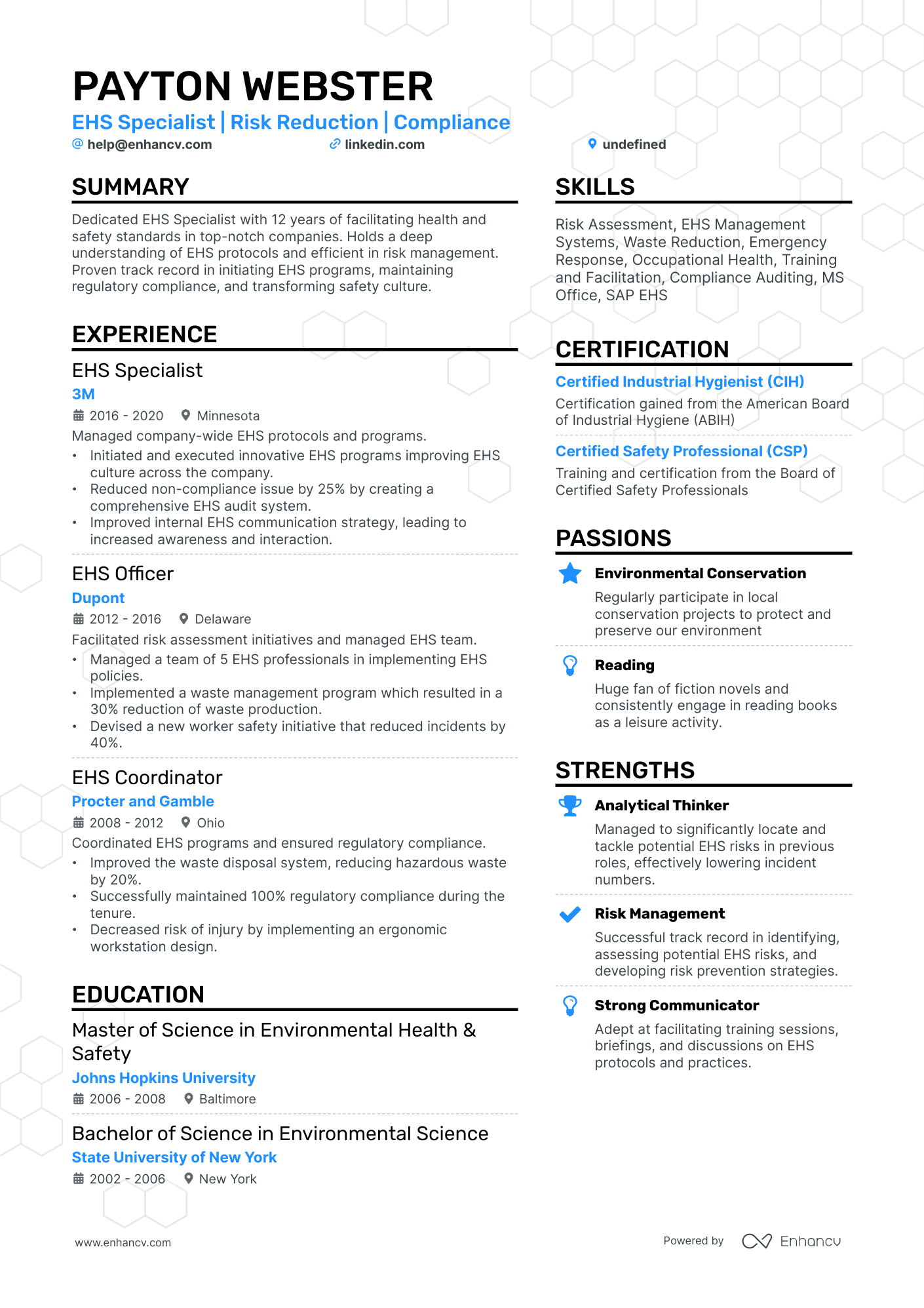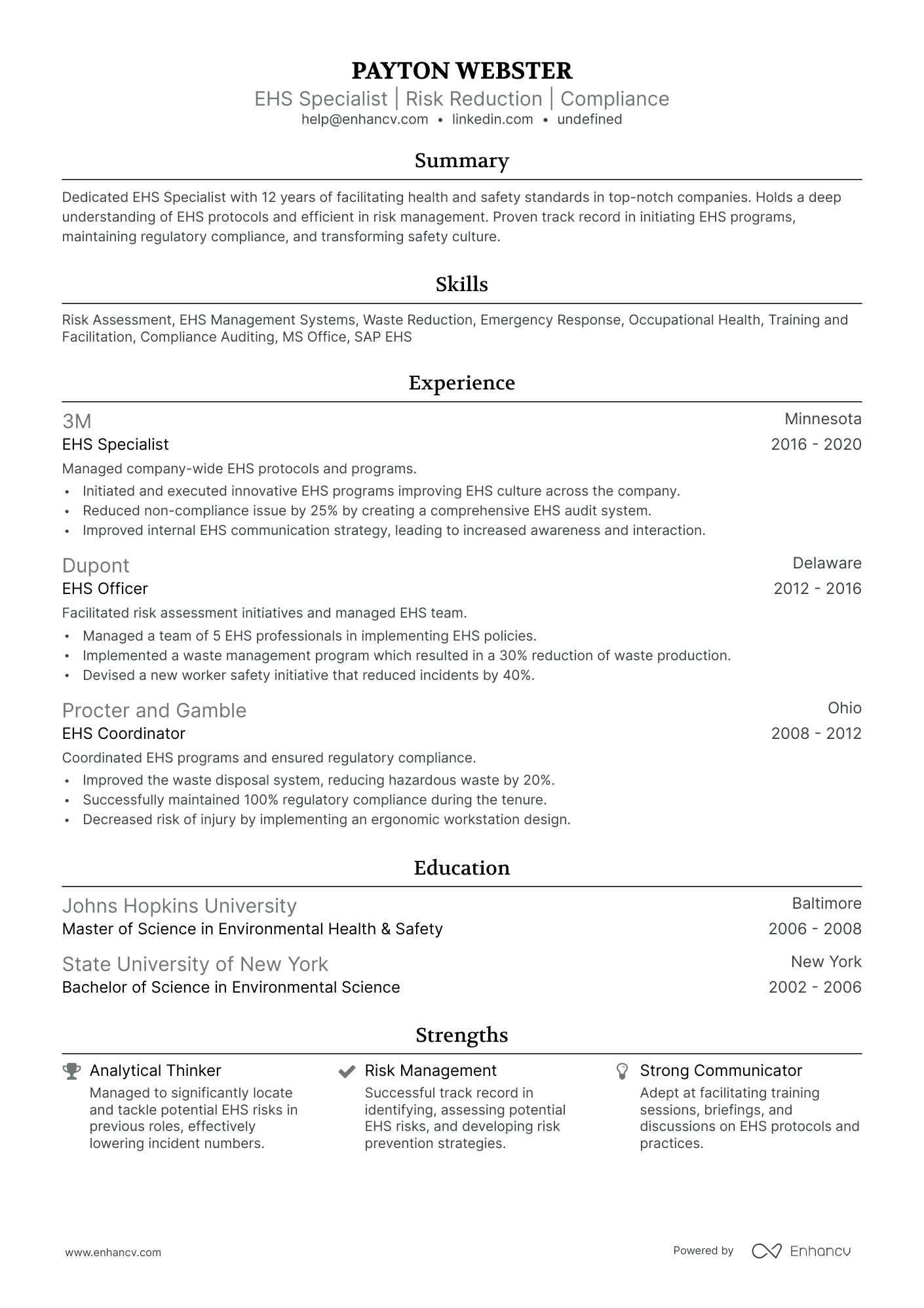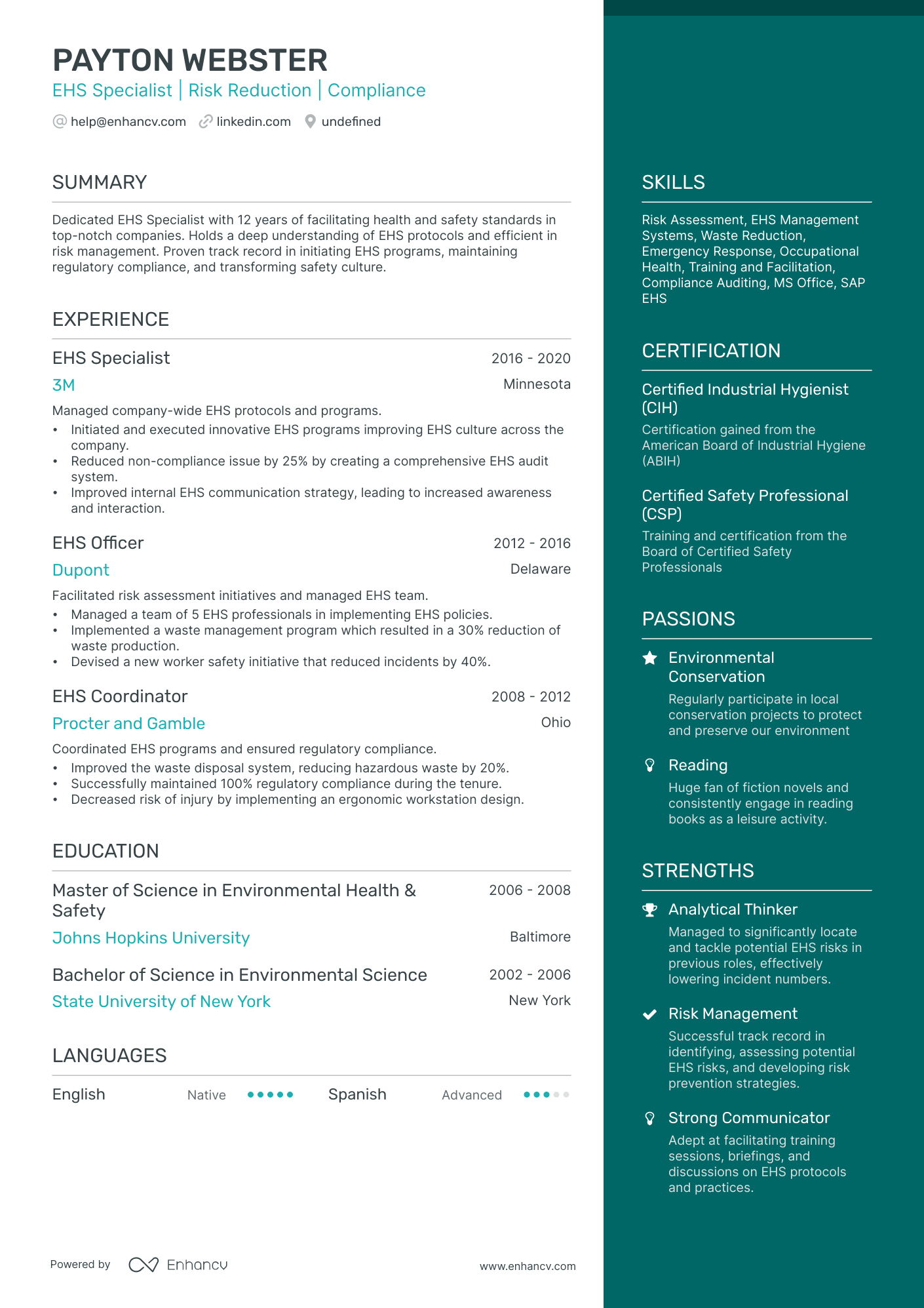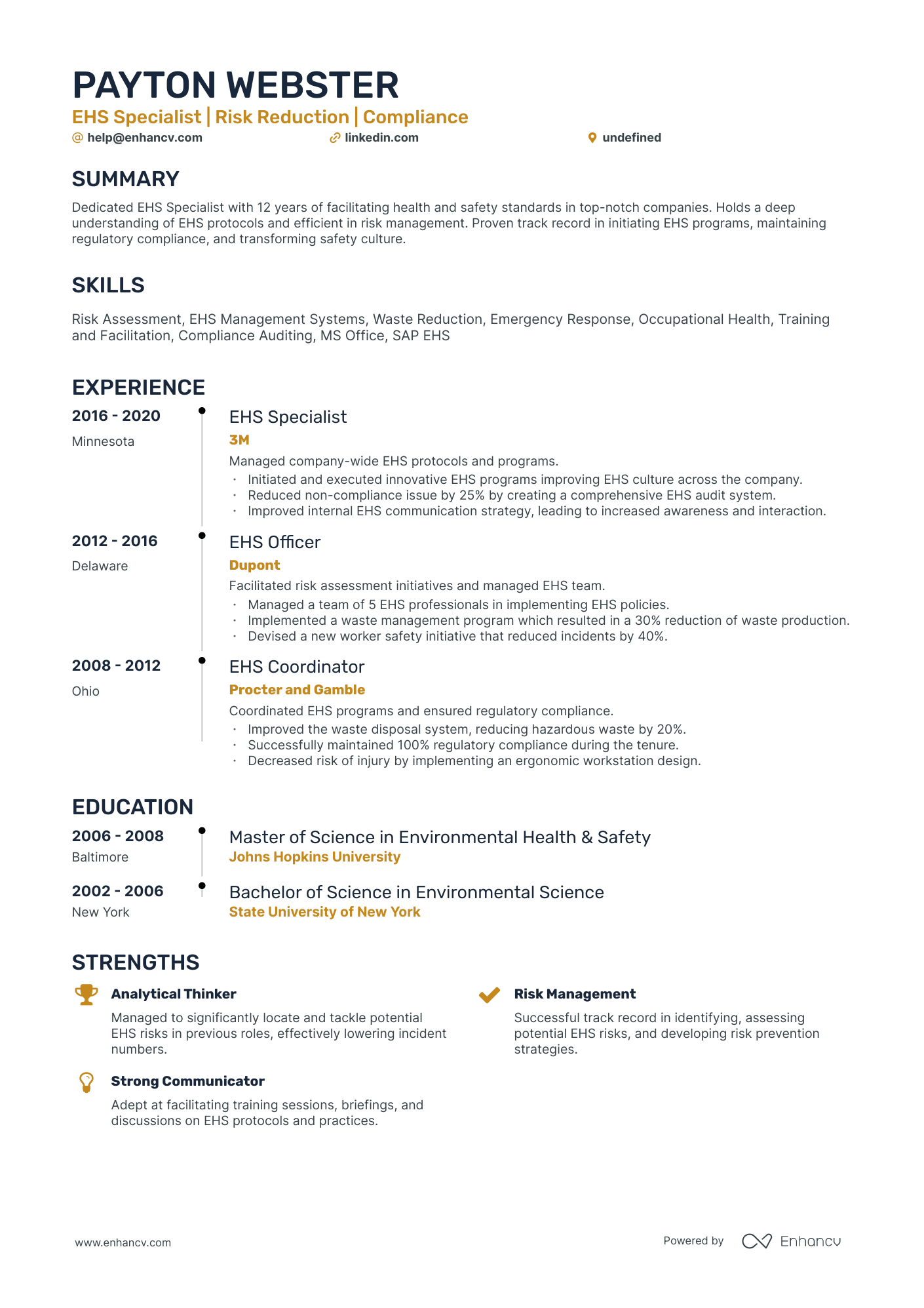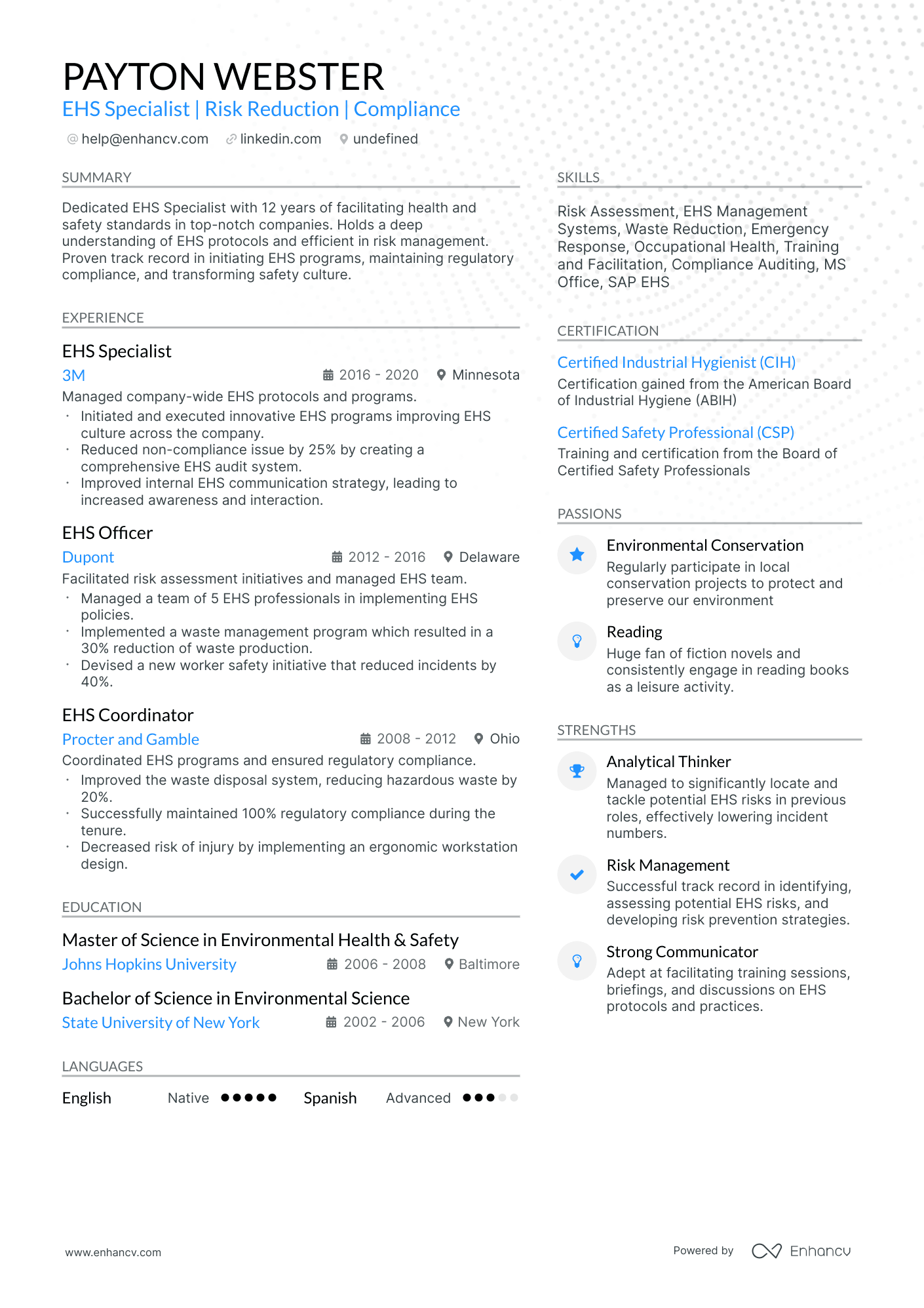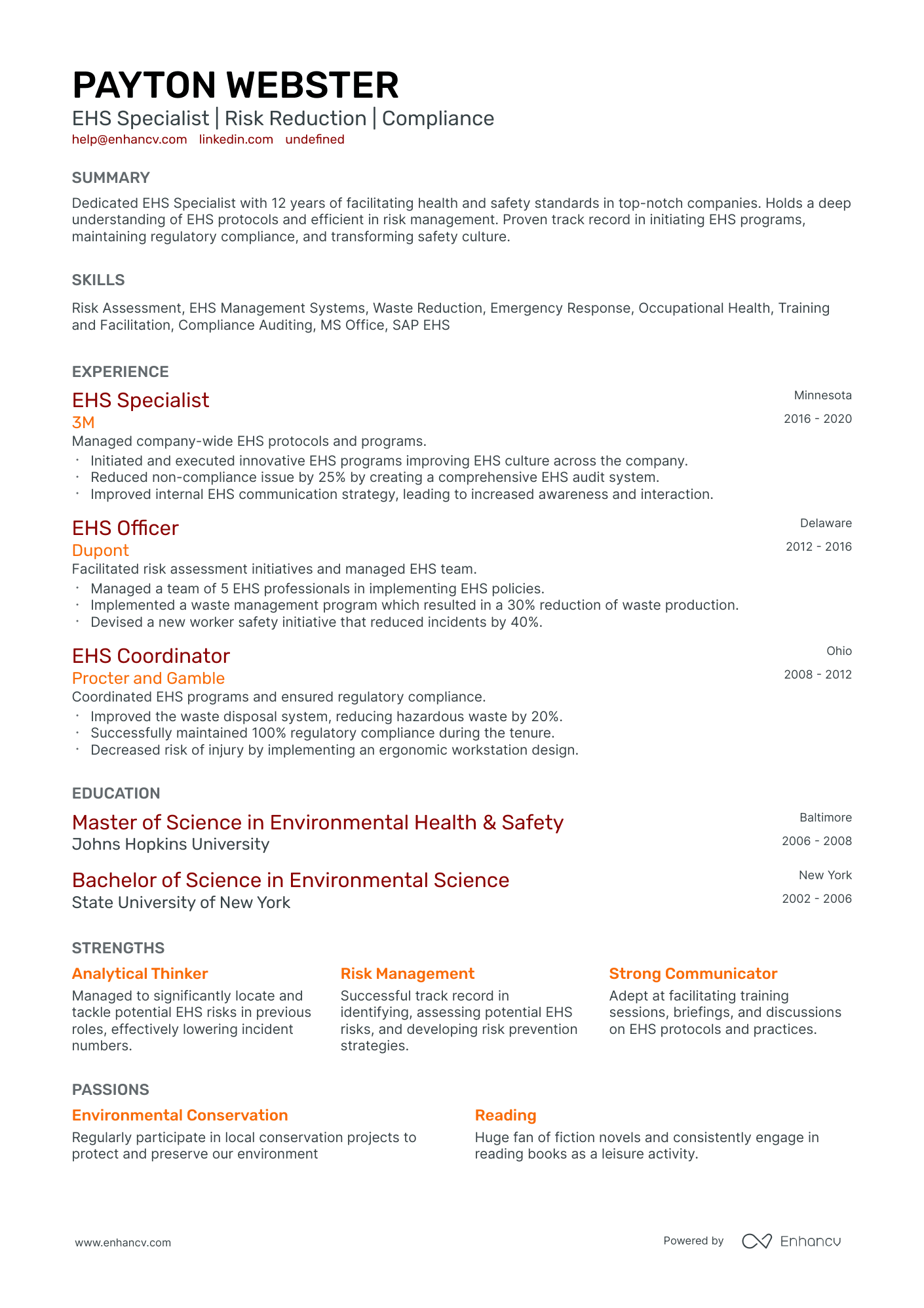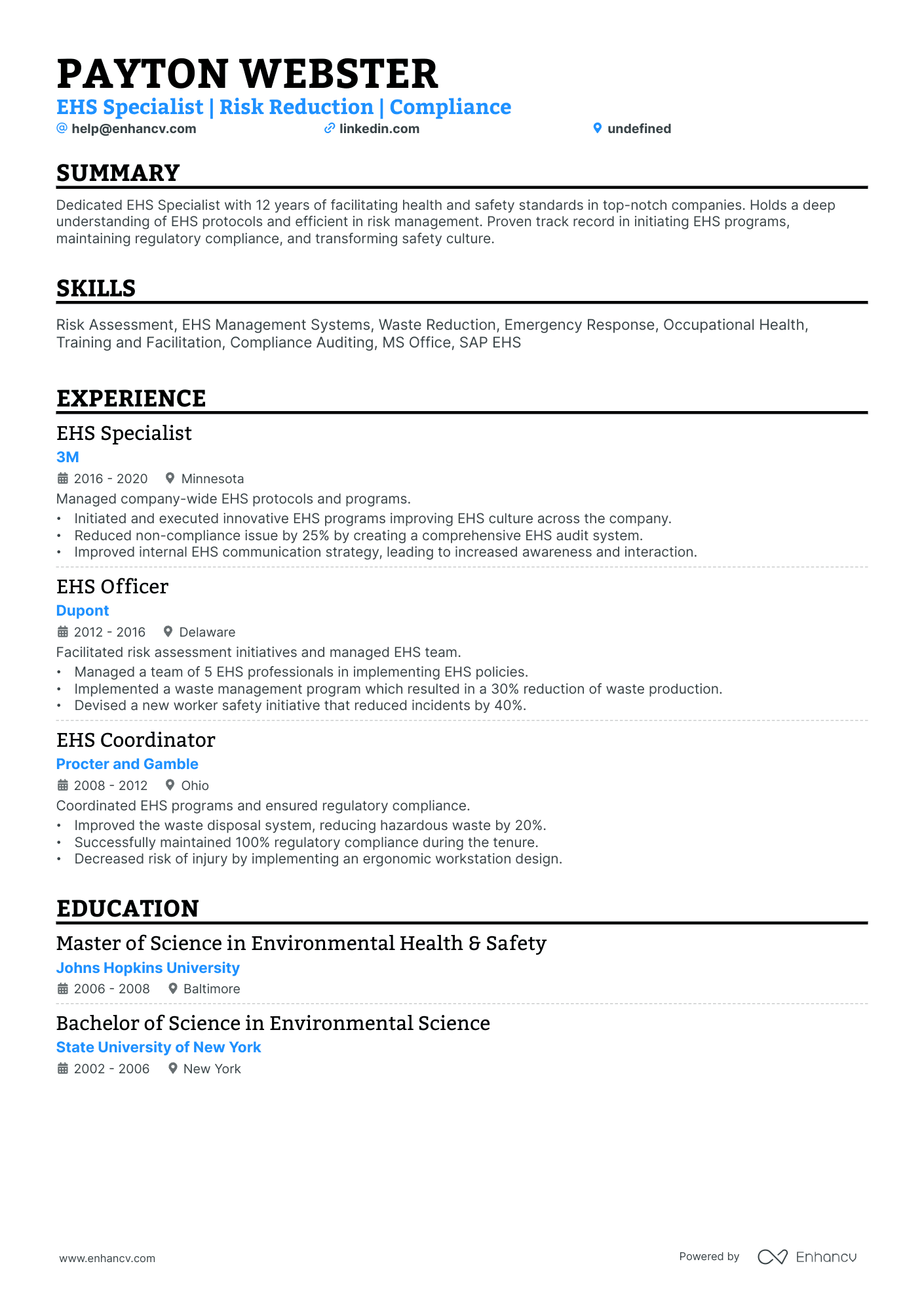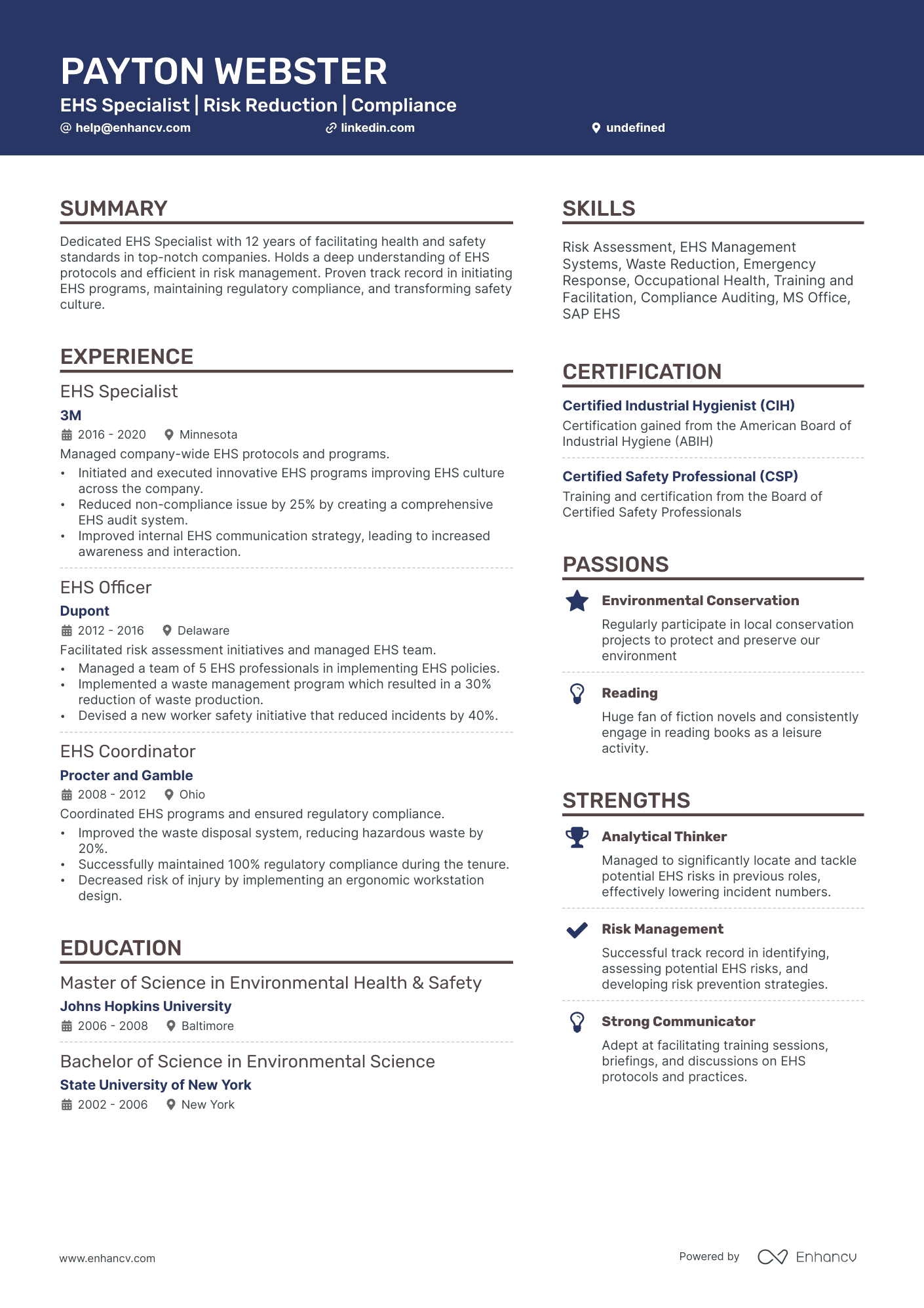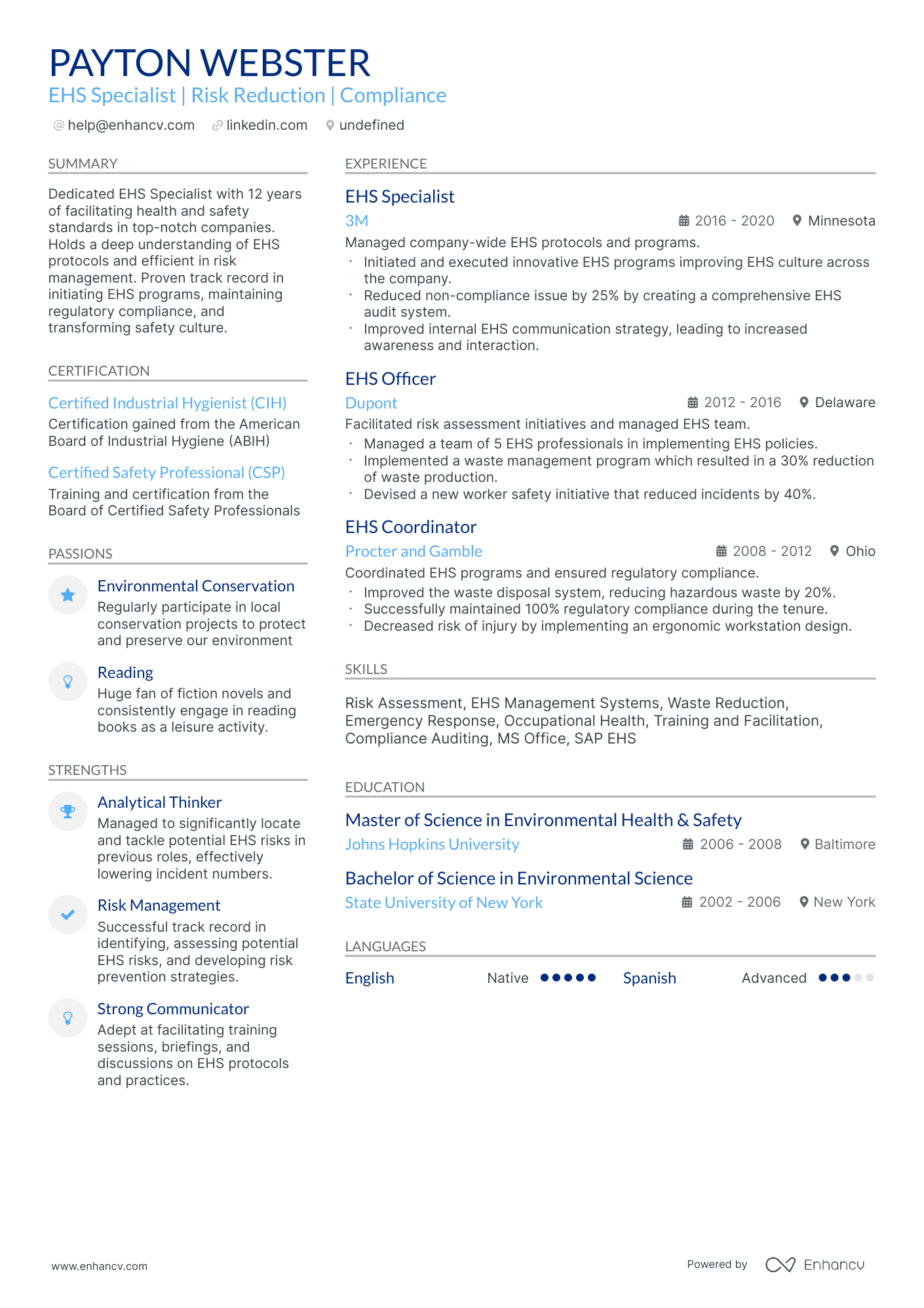EHS specialists often struggle to effectively showcase their wide range of skills, including their knowledge of environmental regulations, ability to conduct risk assessments, and capacity for creating safety training programs, in a concise yet compelling manner. Our guide can assist by providing specific examples and templates that help EHS specialists structure their resumes, highlighting their diverse skillset and experience in a way that captures the attention of potential employers.
Dive into our concise guide to learn how to:
- Show your EHS specialist career's brightest moments through your resume's summary, objective, and experience sections.
- Explore top-notch EHS specialist resume examples to understand how to distinguish yourself from other candidates.
- Identify the most sought-after EHS specialist skills and certifications in the industry.
- Design a structured yet unique resume layout.
Recommended reads:
Demystifying the EHS specialist resume format
While a touch of creativity can be appealing, it's the clarity and relevance of your EHS specialist resume format that truly resonates with recruiters.
To ensure your resume not only captures attention but also maintains it, consider these four streamlined steps:
- If your career boasts a wealth of pertinent and recent accomplishments, the reverse-chronological resume format is your ally. It naturally emphasizes your experience, placing your most recent roles at the forefront.
- Design a straightforward header: incorporate your contact information, a headline reflecting the position you're vying for or your current designation, and a link to your professional portfolio.
- While brevity is key, if you're targeting a senior position or have accumulated over ten years of industry-relevant experience, extending your resume to two pages is permissible.
- To ensure consistent formatting across various platforms, always save and submit your EHS specialist resume as a PDF.
Upload your resume
Drop your resume here or choose a file. PDF & DOCX only. Max 2MB file size.
Pro tip
Choose a legible, professional font for your EHS specialist resume, such as Arial or Calibri.
Must-have sections on a EHS specialist resume:
- A header to list your job title and contact information
- A resume summary or objective which highlights your top career achievements
- A detailed experience section where you emphasize the breadth of your expertise
- A skills box to put the spotlight on your social talents and technical strengths
- An education and certifications section which features your qualifications
What recruiters want to see on your resume:
- Understanding of EHS Regulatory Standards: Detailed knowledge of environmental, health and safety regulations and ability to apply them to practical situations.
- Certification: Credentials such as Certified Safety Professional (CSP), Certified Industrial Hygienist (CIH), or other relevant certifications specific to the field.
- Experience with Risk Assessments: Demonstrated ability to conduct and analyze risk assessments to ensure company-wide safety compliance.
- Incident Management Experience: Proven experience in incident response, including conducting investigations and implementing corrective actions.
- Training Skills: Ability to plan and execute effective EHS training programs for employees at all levels of the organization.
Recommended reads:
Optimizing the experience section of your EHS specialist resume
The experience section is pivotal—it bridges the gap between your qualifications and the job's requirements.
To craft an impactful EHS specialist experience section, consider these guidelines:
- Review the job posting to identify key requirements and align your past roles with these needs.
- Go beyond listing skills—demonstrate their impact through quantifiable achievements.
- Exclude roles that don't enhance your application or showcase relevant skills.
- While technical expertise is crucial, also highlight soft skills that add value to your role.
- Use action verbs to articulate your accomplishments and the skills employed to achieve them.
Below, we've provided EHS specialist resume samples to inspire your experience section, ensuring it adheres to industry best practices.
- Developed and implemented comprehensive environmental health and safety programs, resulting in a 30% reduction in workplace incidents.
- Conducted regular safety audits and inspections to ensure compliance with OSHA regulations and identified areas for improvement.
- Led emergency response drills and training sessions, improving employee preparedness for potential accidents or disasters.
- Collaborated with cross-functional teams to investigate incidents, identify root causes, and implement corrective actions.
- Managed hazardous waste disposal processes, ensuring compliance with local, state, and federal regulations.
- Implemented a behavior-based safety program, resulting in a 25% decrease in lost-time incidents.
- Developed and delivered EHS training programs to enhance safety awareness and promote a culture of compliance.
- Performed risk assessments and developed control measures to mitigate workplace hazards.
- Led incident investigations and prepared comprehensive reports with recommendations for preventing recurrence.
- Maintained regulatory compliance by monitoring changes in environmental, health, and safety regulations.
- Created and managed the company's ergonomics program, reducing musculoskeletal injuries by 20%.
- Developed and implemented safety policies and procedures to ensure compliance with industry standards.
- Conducted safety training sessions for employees and contractors, covering topics such as hazard communication and personal protective equipment.
- Led the investigation and resolution of safety-related incidents, implementing preventive measures to minimize recurrence.
- Collaborated with regulatory agencies during inspections, maintaining a strong record of compliance.
- Performed comprehensive risk assessments to identify workplace hazards and develop mitigation strategies.
- Implemented a waste reduction program, resulting in a 15% decrease in hazardous waste generation.
- Conducted safety audits and inspections to ensure adherence to company policies and governmental regulations.
- Developed and delivered safety training programs for employees at all levels of the organization.
- Assisted in the design and installation of safety systems and equipment to enhance workplace safety.
- Led the implementation of an incident reporting system, resulting in a 40% increase in near-miss reporting.
- Developed and executed safety improvement projects, reducing workplace accidents by 15%.
- Conducted health and safety inspections, identifying areas for improvement and ensuring compliance with regulations.
- Collaborated with cross-functional teams to address ergonomic concerns and implement corrective actions.
- Managed the company's chemical hygiene program, ensuring safe handling and storage of hazardous substances.
- Developed and implemented a behavior-based safety observation program, resulting in a 20% reduction in recordable incidents.
- Conducted job hazard analyses to identify potential risks and recommended control measures.
- Provided guidance on the selection and use of personal protective equipment to mitigate workplace hazards.
- Led safety committee meetings and facilitated discussions on safety initiatives and best practices.
- Collaborated with engineering teams to ensure safety compliance during the design and installation of new equipment.
- Managed environmental permits and regulatory reporting, ensuring compliance with all applicable laws and regulations.
- Conducted ergonomic assessments and implemented improvements resulting in a 30% decrease in employee complaints.
- Developed and delivered training programs on hazardous materials handling and emergency response procedures.
- Led incident investigations and root cause analyses, implementing corrective actions to prevent recurrence.
- Maintained safety data sheets (SDS) and chemical inventory, ensuring accessibility and accurate documentation.
- Developed and implemented safety policies and procedures to meet OSHA and EPA requirements.
- Conducted safety audits and inspections to identify non-compliance issues and recommend corrective actions.
- Provided training to employees on topics such as hazard communication, lockout/tagout, and respiratory protection.
- Led incident investigations and prepared reports detailing findings and recommendations for improvement.
- Collaborated with maintenance teams to ensure safe work practices during equipment maintenance and repairs.
- Managed the implementation of an online safety training platform, increasing employee participation by 50%.
- Conducted risk assessments and developed safety protocols for hazardous work activities.
- Led a cross-functional team in developing and implementing a contractor safety management program.
- Collaborated with engineering teams to incorporate safety features into the design of new machinery.
- Performed incident trend analysis and provided recommendations to reduce workplace injuries.
- Developing and implementing EHS policies and procedures in compliance with local, state, and federal regulations.
- Conducting regular inspections and audits to identify hazards and ensure regulatory compliance.
- Leading incident investigations and implementing corrective actions to prevent recurrence.
- Providing safety training and promoting awareness through various communication channels.
- Collaborating with cross-functional teams to integrate safety practices into daily operations.
Quantifying impact on your resume
<ul>
Writing your EHS specialist experience section without any real-world experience
Professionals, lacking experience, here's how to kick-start your EHS specialist career:
- Substitute experience with relevant knowledge and skills, vital for the EHS specialist role
- Highlight any relevant certifications and education - to showcase that you have the relevant technical training for the job
- Definitely include a professional portfolio of your work so far that could include university projects or ones you've done in your free time
- Have a big focus on your transferable skills to answer what further value you'd bring about as a candidate for the EHS specialist job
- Include an objective to highlight how you see your professional growth, as part of the company
Recommended reads:
Pro tip
Remember, the experience section isn't just about traditional roles. It's a space to highlight all professional learning, whether from internships, contract roles, research projects, or other relevant experiences. If it's added value to your skill set for the EHS specialist role, it deserves a mention.
Highlighting your hard and soft skills on your EHS specialist resume
The skills section of your EHS specialist resume should showcase your capabilities that align with job requirements.
Your hard skills, or technical skills, demonstrate your proficiency with technological innovations and specific software. On the other hand, your soft skills illustrate how you'd excel in the workplace environment with personal attributes like resilience, negotiation, and organization.
For a well-rounded EHS specialist resume, it's essential to include both. Here's how to craft a standout skills section:
- Prioritize skills listed at the top of the job advert.
- Highlight unique skills you've honed over time.
- Choose soft skills that resonate with the company or department culture.
- Address essential job requirements by listing key skills for the EHS specialist role that haven't been mentioned elsewhere in your resume.
Check out our sample skill list for EHS specialist to get ideas on the most sought-after hard and soft skills in the industry.
Top skills for your EHS specialist resume:
OSHA Regulations
Environmental Compliance Software
Risk Assessment Tools
Incident Reporting Systems
Hazardous Materials Management
Safety Management Systems
Environmental Impact Assessment
Data Analysis Software
Training and Presentation Tools
Air Quality Monitoring Equipment
Communication
Problem-Solving
Attention to Detail
Team Collaboration
Critical Thinking
Time Management
Adaptability
Conflict Resolution
Leadership
Interpersonal Skills
Pro tip
If you're in the process of learning a pivotal skill for the role, mention this on your resume. It demonstrates initiative while maintaining transparency.
Highlighting certifications and education on your EHS specialist resume
Your academic achievements, including certifications and degrees, bolster your application. They showcase your skills and commitment to the field.
To effectively present these on your resume:
- Highlight significant academic achievements or recognitions relevant to the role.
- Be selective; prioritize the most relevant and impressive certifications.
- Include essential details: certificate/degree name, institution, graduation dates, and license numbers (if applicable).
- Present your academic background in reverse chronological order, emphasizing the most recent and relevant qualifications.
For further guidance, explore popular industry certifications.
Best certifications to list on your resume
- Certified Industrial Hygienist (CIH) - American Board of Industrial Hygiene
- Applied Microbial Remediation Technician (AMRT) - Institute of Inspection, Cleaning and Restoration Certification
- Registered Environmental Health Specialist/Registered Sanitarian (REHS/RS) - National Environmental Health Association
Pro tip
If you're in the process of obtaining your certificate or degree, list the expected date you're supposed to graduate or be certified.
Recommended reads:
Crafting the EHS specialist resume summary or objective: a blend of achievements, aspirations, and uniqueness
Whether you opt for a resume summary or objective depends on your career trajectory.
- If you have a rich tapestry of relevant achievements, a resume summary can spotlight these accomplishments.
- If you're relatively new or transitioning, a resume objective can articulate your aspirations and how they align with the role.
Regardless of your choice, this section should encapsulate your unique value proposition, blending your technical and interpersonal strengths.
Resume summary and objective examples for a EHS specialist resume
- A seasoned EHS specialist boasting a decade of experience, adept in reducing workplace hazards and ensuring regulatory compliance. Skilled in conducting safety audits, delivering training, and managing incident reports. Notable achievement: Successfully reduced OSHA recordable incidents by 40% at ABC Corporation within the first two years of role.
- Outstanding professional offering 8+ years' experience as an Industrial Hygienist transitioning into EHS field. Proven competencies in hazard identification, risk assessments and implementing proactive health & safety protocols. Brought down injury rates by over 35% in former organization through extensive worker education programs.
- Nationally Certified Safety Professional with 7 years of practice in construction industry looking to leverage expertise in implementing safety procedures, conducting site inspections, and mitigating risks into an EHS specialist role. Recognized for leading a project that improved safety standards, resulting in a 30% decrease in incidents.
- Experienced Mechanical Engineer with a track record of maintaining safety regulations now seeking to apply this knowledge to an EHS specialist position. With 5 years of hands-on experience, I possess sound judgment and decision-making skills in hazardous situations. Key accomplishment: Guided a team that successfully passed all safety inspections without any non-compliances at XYZ Company.
- Eager to launch my career as an EHS specialist. As a recent graduate in Environmental Science, I am equipped with a solid academic foundation in EHS principles and regulations. My goal is to use my strong analytical skills and commitment to safety to ensure adherence to all relevant standards and contribute positively to company safety culture.
- Highly motivated Environmental Science graduate aspiring to join the workforce as an EHS specialist. An effective communicator with strong problem-solving abilities, aiming to utilize my academic knowledge and internship experience to assure environmental, health, and safety compliance while promoting a culture of continuous improvement.
Additional sections to elevate your EHS specialist resume
Recruiters often seek candidates who offer more than just the basics.
To stand out, consider adding:
- Interests: Share hobbies or activities that reveal your personality and transferable skills.
- Projects: Highlight innovative work that showcases your expertise.
- Languages: If communication is vital for the role, showcase your linguistic abilities.
- Awards: Feature significant recognitions that underscore your expertise.
Key takeaways
- Craft a EHS specialist resume that's easy to read and aligns with the role's requirements.
- The top third of your resume should clearly convey your unique value proposition for the EHS specialist role.
- Tailor your resume to the job, highlighting skills, achievements, and the tangible results of your efforts.
- Detail your certifications and technical skills to demonstrate proficiency with specific tools and technologies.
- The sections you choose should collectively present a comprehensive view of your professional expertise and personality.
